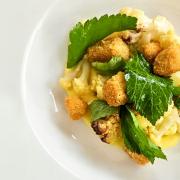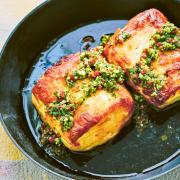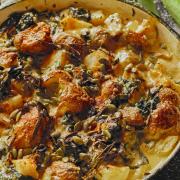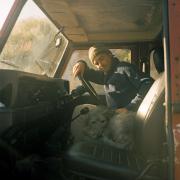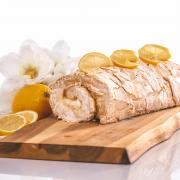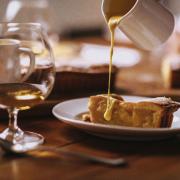Between mid- April and the end of May Dorset’s ancient woods and hedgerows are filled with the pungent smell of wild garlic (Allium ursinum). It's also known as ramsons, buckram and wood garlic, as well as bear’s leek and bear’s garlic, the latter two refer to the ursinum part of its Latin name, apparently brown bears, which no longer roam wild in the British Isles, loved to eat the garlic bulb.

Wild garlic is forager’s dream ingredient, its strong smell means that it is easy to identify and it usually grows in abundance. Stir the young leaves through a risotto, soups and stir fries, or combine with butter to make wild garlic bread or stir the wild garlicky butter through warm new potatoes. Add the starry white flowers to salads and sandwiches for a garlic kick.

Where to find wild garlic in Dorset: Wild garlic favours deciduous woodland and chalky soils, it also pops up in hedgerows, but the key factor is that it prefers damp areas. Wild garlic hot spots in Dorset include Garston Wood near Sixpenny Handley, Kilwood Nature Reserve near Church Knowle, Kingswood near Corfe Castle (in fact the name of nearby Rempstone means 'farm where wild garlic grows'), Hooke Woods and Edmund Combe Coppice near Beaminster, Langdon Wood, Powerstock Woods, Hazel Coppice and Declombe Woods near Milton Abbas. It’s worth checking out the Woodland Trust website to find ancient woodland near you

Forage mindfully: Don't clear an area of all the wild garlic, only pick enough for your needs. Be careful that you are only picking wild garlic leaves, poisonous plants with similar looking leaves that also like the same damp conditions include cuckoo pint, bluebells, daffodils and autumn crocus, these can get mixed into your foraging if you are grabbing handfuls of leaves. You know you have the right leaves if they smell strongly of garlic.

James Golding from The Pig shares some wild garlic recipes
Pestos are wonderful – they’re quick, easy, cheap to make, and they pack a lovely flavoursome punch. Here are two variations that use herbs you can either grow in your garden or forage for. The first, wild garlic, pops up almost anywhere in the southern English countryside from late March, and it’s completely delicious. Alexander, which is sometimes called horse parsley, was brought here by the Romans, who used it to feed their horses. We use these two recipes to go with everything from simple grilled fish to homemade pasta.

Wild garlic pesto
Makes 250g
Ingredients
•125g wild garlic
•50g hazelnuts
•50ml walnut oil
•1 teaspoon apple cider vinegar
•2½ teaspoons rapeseed oil
•a squeeze of lemon juice (optional)
•salt and pepper
Method: As soon as you pick the wild garlic, wash it gently, then blanch in a pan of boiling water and plunge immediately into a bowl of iced water to stop the cooking process. Drain and squeeze off any excess water. Lightly toast the hazelnuts under the grill until browned. Put all the ingredients, except the lemon juice, salt and pepper, in a blender or food processor and pulse to a chunky paste. You’re not looking for a watery purée – it’s much nicer with larger pieces. Add seasoning and lemon juice to taste.

Rocket and alexander pesto
Makes 250g
Ingredients
•150g rocket
•25g alexander (if you can’t find it, use celery leaves or flat leaf parsley)
•5g garlic (if using on a fish dish; increase to 15g for meat)
•zest of 2 lemons, or 1 chopped preserved lemon
•50ml rapeseed oil
•salt and pepper
Method: Put all the leaves, garlic and lemon zest in the food processor and blitz. Mix in the rapeseed oil and season to taste.
TRY THIS CLASSIC PIE RECIPE FROM THE PIG
How to cook with wild garlic all year: The wild garlic season only last a few weeks. TO make it stretch a little longer, we like to preserve a good batch. First, we blanch to leaves in boiling water for 15 seconds, after which we immediately plunge them into cold water. We then pat them dry, blitz to a puree, then freeze. You can also freeze both these pestos.

All recipes taken from The Pig: Tales and Recipes from the Kitchen Garden and beyond published by Mitchell Beazley £25. Buy online here or swing by The Pig on the Beach at Studland or any of their other Pigs. The Pig Hotels are welcoming back now, book online at thepighotel.com




